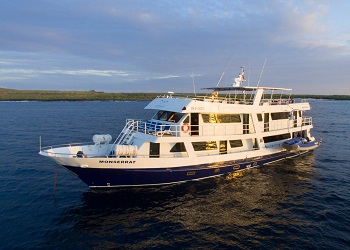Coral I&II Itinerary B - 5 Days
ITINERARY B - 5 DAYS
WEDNESDAY
AM: Baltra Arrival and Transfer to the Boat
PM: Santa Cruz: Black Turtle Cove (PR)
THURSDAY
AM: Isabela: Vicente Roca Point (PR/SN)
PM: Fernandina: Espinosa Point (HK/SN/PR)
FRIDAY
AM: Isabela: Urbina Bay (HK/SN)
PM: Isabela: Tagus Cove (HK/KY/SN/PR)
SATURDAY
AM: Santiago: Egas Port (HK/SN)
PM: Santiago: Sullivan Bay (HK/SN)
SUNDAY
AM: Santa Cruz: Highlands Tortoise Reserve (HK)
Baltra: Transfer to the Airport
HK: HIKE / SN: SNORKEL / PR: PANGA RIDE / KY: KAYAK /
PB: PADDLE BOARD
DAY 1 : WEDNESDAY
AM: BALTRA ARRIVAL AND TRANSFER TO THE BOAT
Departure from either Quito or Guayaquil to Baltra Island is a 2 ½ hour flight. Upon arrival in the Galapagos, passengers are greeted at the airport by our knowledgeable guides who will accompany them on a short ten-minute bus ride to the pier where they will board the Coral I or Coral II.
PM: SANTA CRUZ: BLACK TURTLE COVE
Here we can find four species of mangrove in the extensive tidal lagoon system that stretches for almost a mile inland. During our panga ride through the labyrinth we will spot many turtles, herons of several species, sharks and rays. The experience is otherworldly and seems to transport us back to the beginning of time.
DAY 2: THURSDAY
AM: ISABELA: VICENTE ROCA POINT
Spectacular site, surrounded by immense cliffs of an eroded volcano. Studded with resting seabirds like brown noddies and Nazca boobies. Superb snorkeling with unique fish species. Swim with penguins and green turtles.
PM: FERNANDINA: ESPINOZA POINT
Pristine Fernandina, the marine iguana capital. Its desolate volcanic backdrop hosts a massive concentration of these enigmatic reptiles. Surprisingly, Galapagos penguins share the same shoreline. Snorkeling offers an exciting opportunity to witness marine iguanas feeding underwater, alongside penguins, turtles, and unique flightless cormorants.
DAY 3: FRIDAY
AM: ISABELA: URBINA BAY
At the far end of a long level hike, we arrive at a strange phenomenon where large blocks of coral lie completely exposed after a dramatic geological uplift in 1954. Located at the western base of Alcedo Volcano, we hope to run into a few impressive land iguanas and some volcanoes endemic to Galapagos giant tortoises during the wet season.
PM: ISABELA: TAGUS COVE
Tagus Cove, a historic pirate hideout and anchorage. Visited by Charles Darwin and the HMS Beagle in 1835. Hike past Darwin Lake and stunning volcanic landscape, revealing Isabela island's dramatic northern volcanoes. Snorkel along a submerged wall with turtles, fish, penguins, and flightless cormorants. Enjoy a panga ride or kayak for added excitement!
DAY 4: SATURDAY
AM: SANTIAGO: EGAS PORT
The black volcanic sand sets this landing apart from most, it's best known for the dramatic shoreline where we meet a host of species that chose to live between land and sea. Among these are the endemic Galapagos fur seals, which maintain a small colony at the end of our walk.Egas Port (Santiago Island).
PM: SANTIAGO: SULLIVAN BAY
It has an extensive features relative to young pa-hoe-hoe lava flows formed during the last quarter of the 19th century. In the middle of the lava flow, older reddish-yellow-colored tuff cones appear. Mollugo plants with their yellow-to-orange whorled leaves usually grow out of the fissures. Walking on solidified lava gives the impression of being on another planet.
DAY 5: SUNDAY
AM: SANTA CRUZ: HIGHLANDS TORTOISE RESERVE / BALTRA TRANSFER TO THE AIRPORT
In the central highlands of Santa Cruz Island, we have our best opportunity to interact at close quarters with totally wild, Galapagos giant tortoises. A short walk among these huge, 600lb, reptiles will also offer the chance for more highland species, especially several species of the famed finches.
Baltra Island Airport after the visit, passengers will be transferred to the airport for their return flight to Guayaquil or Quito.







